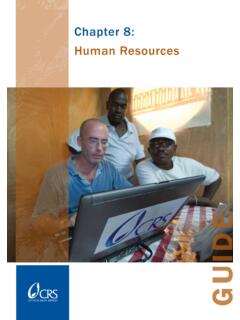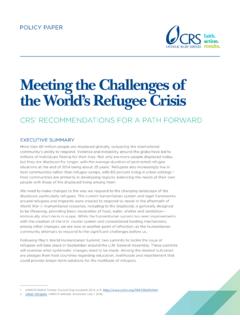Transcription of Health, Safety, and Nutrition - Catholic Relief Services
1 health , safety , and NutritionTRAINING FOR EARLY CHILDHOOD CAREGIVERS AND TEACHERSMODULE 6 RESOURCE GUIDEHEALTH, safety , AND Nutrition iMODULE 6 RESOURCE GUIDEH ealth, safety , and Nutrition TRAINING FOR EARLY CHILDHOOD CAREGIVERS AND TEACHERSii MODULE 6 RESOURCE GUIDEThis guide is part of a series of manuals that focuses on six topics in Early Childhood Development (ECD): different programming approaches, basic concepts, assessments, early childhood environments, children with special needs and child protection, and the health , safety and Nutrition of young children. The series was prepared within a three-year CRS-led project called Strengthening the Capacity of Women Religious in Early Childhood Development, or SCORE ECD. Funded by the Conrad N. Hilton Foundation, the project helps Catholic sisters in Kenya, Malawi, and Zambia in their work with children aged 0-5 years and their families.
2 The project is being implemented from January 2014 to December referred to a wide range of documents in preparing this curriculum. Please see Reference Documents section in Module 1 facilitator or resource guide for the full by Selamawit Tadesse, in cooperation with CRS SCORE ECD by David SnyderCover photo: Pilarini James, 8 months, is fed by his mother in Chinganga Village near Zomba, Malawi. His mother participates in a CRS project funded by the Hilton Foundation that trains new and expectant mothers in Nutrition and hygiene. Sara A. Fajardo/CRSC opyright 2016 Catholic Relief ServicesAny reproduction, translation, derivation, distribution or other use of this work is prohibited without the express permission of Catholic Relief Services ( CRS ). Please obtain permission from or write to: Catholic Relief Services228 West Lexington StreetBaltimore, MD 21201-3443 USAHEALTH, safety , AND Nutrition iiiTable of ContentsRESOURCE GUIDE 6: health , safety , AND Nutrition OF YOUNG CHILDREN.
3 1 Purpose ..1 SESSION 1: health AND safety OF YOUNG objectives ..3 health and safety of young children ..3 Germs and their effect on health ..4 Keeping children safe ..7 Childhood illnesses: Integrated Management of Childhood Illnesses (IMCI) and ideas for working with caregivers ..10 Ideas for working with parents and family caregivers ..13 SESSION 2: GROWTH AND Nutrition OF YOUNG CHILDREN ..17 Learning objectives ..17 Caring for the child s healthy growth and development: WHO-UNICEF training manual ..17 REFERENCES ..19iv MODULE 6 RESOURCE GUIDERESOURCE GUIDE 6: health , safety , AND NUTRITIONR esource Guide 6 is one of six ECD Resource Guides from the CRS SCORE ECD curriculum. The six series to Early Childhood Programs to Early Childhood Young Children s Early Childhood Environments for Young Children with Special Needs and Child , safety , and NutritionSAMPLE REVIEW We have been helped in this training to know how to care for the health and safety of children.
4 Sisters will be taking appropriate precautions in treating injuries, sickness, and giving good Nutrition to children, counseling parents on the importance of exclusive breastfeeding, and preparing nutritional food using what they grow in their backyards. (Reviewer: Master Trainer, SCORE ECD project, Zambia, August, 2015) The curriculum was helpful because I have learned more about Nutrition and how to give good food to children according to their different developmental stage. (Reviewer: Master Trainer, SCORE ECD project, Zambia, August, 2015) Sisters were empowered to make use of what we have in the environment and be creative to help families and children keep their health in good condition; we created a tippy-tap to provide families with clean running water for handwashing; we learned how to practically monitor growth of children using graphs; we learned how to counsel mothers in breastfeeding and preparing locally grown nutritious food for children of different ages.
5 (Reviewer: Master Trainer, SCORE ECD project, Zambia, August, 2015) health , safety , AND Nutrition 1 Resource Guide 6: health , safety , and Nutrition of Young Children PURPOSEThe purpose of this guide is to increase the participants understanding of childhood illnesses and injuries, their influence on children s development, and what caregivers can do to prevent and/or treat illnesses and injuries in children. The participants are also expected to learn about Nutrition and its importance in Early Childhood Development (ECD) and what caregivers can do to promote good Nutrition for young children, including children living with HIV. This guide is divided into two sessions: 1. Session one describes the importance of sanitation, safety , and prevention of childhood illnesses for young children. Topics include universal precautions, personal hygiene; food safety ; safe drinking water; preventing injuries; and intervention with Integrated Management of Childhood Illnesses (IMCI) with a focus on children living with Session two describes the importance of Nutrition for young children s development and Nutrition strategies by age for optimum health and development of all children.
6 Topics include responsive feeding and care practices for young children, supporting families to improve infant and young child feeding practices, growth monitoring, and reinforcing healthy eating habits in young children. health , safety , AND Nutrition 3 Session 1: health and safety of Young Children1 LEARNING OBJECTIVES1By the end of this session, the participants will be able to: Describe the effects of germs on health . Identify ways to prevent germs from spreading among children and adults. Define Universal Precautions and the need to use universal precautions all the time when dealing with blood and bodily fluids. Put measures in place to prevent accidents in and around the home and school. Respond quickly and appropriately to accidents. Describe common childhood illnesses and the danger signs of childhood illnesses that require urgent medical attention.
7 Identify steps that are helpful to prevent or treat childhood illnesses. health AND safety OF YOUNG CHILDRENI mportant: This session needs to be conducted by or with the assistance of a local health and Nutrition professional. Also, have the national or district health and safety protocol guidelines on hand for reference throughout the This session is adopted from CRS, Lesotho (2012), Ngoana Eo Ke Oa Mang? Parent and family caregiver MODULE 6 RESOURCE GUIDEGERMS AND THEIR EFFECT ON HEALTHC hildren can get sick through germs. Germs are very small living things that make people sick if they get inside their bodies. They are spread in many ways. For example: Through the air when we sneeze Though contact with human feces or urine By touching something that has germs on it Through contact with blood and their body fluidsSanitation or cleanliness is the best way to stop germs from spreading, so practice it in the home and the community at all OF SANITATION AND SAFETYUNIVERSAL PRECAUTIONSWe cannot tell by looking if someone is infected with HIV.
8 This means we need to treat all blood (and body fluids containing blood) as if it is infected with HIV. Teach children not to touch other people s blood and body fluids. A child who is hurt and bleeding needs immediate attention. Use latex/rubber gloves or plastic bags to protect your hands when dealing with cuts, bleeding or opens sores, and when cleaning up blood spills. Keep the child in one place until you have controlled the bleeding. Wash hands immediately after any contact with blood. Cover grazes, cuts, and open sores with a clean piece of cloth or bandage. Place bloody clothes or paper in double plastic bags before you put them in the rubbish bin. Wash the blood stained area with a disinfectant solution. Soak any mops or cleaning cloths in the disinfectant solution and let them dry in the AND HAND WASHING AND ITS IMPORTANCE Appropriate hand washing can minimize germs on the hands that come from contact with bodily fluids and contaminated surfaces, or touching dead animals.
9 Body/hand washing breaks the chain of infection transmission and reduces the spread of infection from one person to another. All caregivers and staff who provide care for children and adults must practice effective body/hand washing. Children and adults also need to be instructed in proper techniques and situations for body/hand washing. Washing with soap and water kills many germs and allows them to be removed by rinsing. DO NOT USE COMMON TOWELS BECAUSE THEY SPREAD , safety , AND Nutrition 5 FACILITIES AND MATERIALS REQUIRED FOR BODY/HAND WASHING Access to clean water is essential. Running water is best. As many homes do not have running water, it is best to pour a small amount of water from either a bucket with a tap, which can be turned on and off, or a bucket and pitcher to pour water for rinsing. Facilities for drying hands: Disposable towels or reusable single use towels or roller towels, which are regularly washed, should be available.
10 If there is no clean dry towel, it is best to air-dry tippy-tap is a simple device that allows people to wash their hands with very little water. It also allows the user to rub his/her hands together while water runs over them. It is made of materials that are available at no cost in most places and can be put wherever people need to wash their hands, for example, near the cooking stove, at the toilet, or in rural food TO MAKE A PLASTIC TIPPY-TAPTo make this tippy-tap you need: 1) a plastic bottle with a screw-on cap of the sort that cool drinks come in, and 2) the inside tube from a ball-point pen, or some other small, stiff, hollow THE TUBE Using a heated piece of wire, make a small hole in the lower part of the bottle. Remove and clean the inside tube from a ball-point pen. Cut it off at an angle, and push it through the hole in the bottle. The tube should fit tightly.










